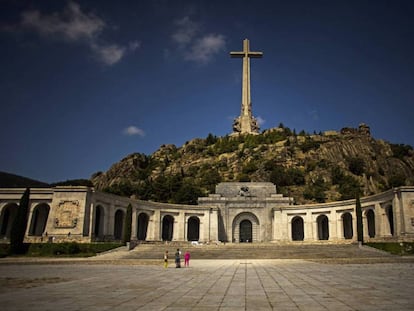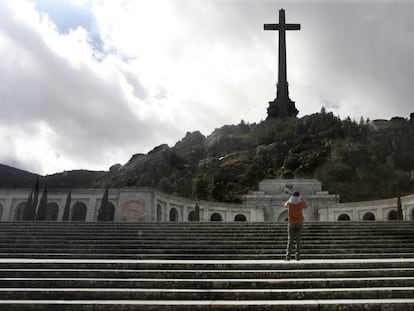Valley of the Fallen: The fight to recover remains from “Spain’s largest mass grave”
Family members of Republicans interred in the controversial site want to exhume their loved ones and give them a dignified burial, but they say the process is taking too long


Mercedes Abril is 86 years old. She last saw her father, Rafael, in 1936, when she was three years old. “They took him away, they killed him and then they hid him.” Much later, she discovered to her horror that his body had been taken to the Valley of the Fallen, a controversial monument, northwest of Madrid, where former Spanish dictator Francisco Franco was buried in 1975.
“Franco is the reason why my mother cried for years, why I never had a childhood, and why my daughters will never know their grandfather, or my grandchildren their great-grandfather,” she says.
They need a dignified burial
Justice Minister Dolores Delgado
The Spanish Supreme Court ruled on Tuesday in favor of Franco’s exhumation from the Valley of the Fallen, rejecting an appeal from the dictator’s family to stop the caretaker Socialist Party government’s plan. Franco’s remains may now be moved to another cemetery before campaigning for the November 10 general election begins. But this will not be enough for Abril. She wants to recover her father’s body from the site, which holds the unmarked remains of more than 33,000 victims of the Spanish Civil War (1936-1939), including Republican fighters whose bodies were taken from mass graves and buried at the monument without their families’ consent.
“Of course it’s a relief that they have allowed the transfer [of Franco’s remains]. It was painful and ridiculous that my father was next to his executioner, as though [Franco] was still watched over him. But there is an unresolved issue that continues to cause pain: I want to have a dignified site to bury my father and to be able to bring him flowers, like any other person. And we are running out of time,” she explains.

Around 20 relatives of Republicans buried in the Valley of the Fallen have requested to have the remains of their family members returned to them. Manuel Lapeña, 95, brought the issue to the courts, and after a lengthy process, won a court order in 2016 to exhume his father and uncle. The government has promised to “do everything possible” to return the remains, but the families are beginning to lose patience with the slow-moving process.
“[On Monday] I received a letter from Prime Minister Sánchez,” says Abril, referring to the leader of the Socialist Party (PSOE), who spearheaded the push to exhume Franco’s remains from the Valley of the Fallen. “He was responding to mine in which I asked him to speed up the exhumations. He replied that they are going to try to solve the situation. But time passes. Many have already passed away without seeing it happen. Only a few children and grandchildren who have not abandoned their grandparents remain.”
The victims of the Valley of the Fallen still need reparation
Lawyer Eduardo Ranzo
On February 26, the Justice Ministry organized for Abril and five other Republican relatives to visit the crypt where their loved ones are buried. “Through a tiny window I saw lots of stacked boxes, each one from a town,” says Abril.
On March 12, then-Justice Minister Dolores Delgado, of the PSOE, delivered a document to 11 families aimed at providing “moral reparation” for their loss. “They were thrown in, not buried,” she stated in the recognition certificate. “The Valley of the Fallen is the largest mass grave in Spain, where the remains of 33,800 people, 18,000 of them Republican live. They need a dignified burial.”
The government has taken DNA samples from the family members to try to identify the remains once they are exhumed. But not all descendants have the same luck. Water has leaked into some of the crypts and destroyed the wooden boxes containing the bones.
Eduardo Ranzo, who represents six of the families of the Republicans, sums up the situation: “Exhuming the dictator is fundamental for this country because it puts an end to a democratic anomaly. But the victims of the Valley of the Fallen still need reparation.”
Valley of the Fallen
The 13.6-square kilometer Valley of the Fallen site remains hotly contested in a country still struggling to come to terms with the legacy of the fascist dictatorship of Franco, who was the Spanish head of state from the end of the Civil War in 1939 to his death in 1975.
The site was ostensibly built to commemorate all of the victims on both sides of Spain's bitter and bloody Civil War (1936-1939), and the unmarked remains of more than 33,000 victims of the conflict lie there. But critics point out that the Valley of the Fallen, which features a basilica and a 150-meter-high cross that dominates the surrounding countryside, contains just two marked graves: those of Franco himself and José Antonio Primo de Rivera, the founder of the Falange, Spain's fascist-inspired political party. At the same time, thousands of prisoners of war who fought against Franco in the civil conflict were among the workforce used in its construction.
English version by Melissa Kitson.
Tu suscripción se está usando en otro dispositivo
¿Quieres añadir otro usuario a tu suscripción?
Si continúas leyendo en este dispositivo, no se podrá leer en el otro.
FlechaTu suscripción se está usando en otro dispositivo y solo puedes acceder a EL PAÍS desde un dispositivo a la vez.
Si quieres compartir tu cuenta, cambia tu suscripción a la modalidad Premium, así podrás añadir otro usuario. Cada uno accederá con su propia cuenta de email, lo que os permitirá personalizar vuestra experiencia en EL PAÍS.
¿Tienes una suscripción de empresa? Accede aquí para contratar más cuentas.
En el caso de no saber quién está usando tu cuenta, te recomendamos cambiar tu contraseña aquí.
Si decides continuar compartiendo tu cuenta, este mensaje se mostrará en tu dispositivo y en el de la otra persona que está usando tu cuenta de forma indefinida, afectando a tu experiencia de lectura. Puedes consultar aquí los términos y condiciones de la suscripción digital.
More information
Archived In
Últimas noticias
Most viewed
- Reinhard Genzel, Nobel laureate in physics: ‘One-minute videos will never give you the truth’
- Oona Chaplin: ‘I told James Cameron that I was living in a treehouse and starting a permaculture project with a friend’
- Pablo Escobar’s hippos: A serious environmental problem, 40 years on
- Why we lost the habit of sleeping in two segments and how that changed our sense of time
- Chevy Chase, the beloved comedian who was a monster off camera: ‘Not everyone hated him, just the people who’ve worked with him’










































